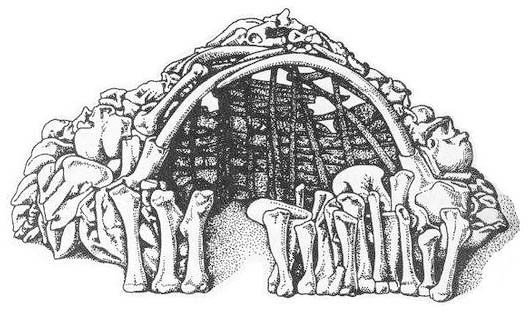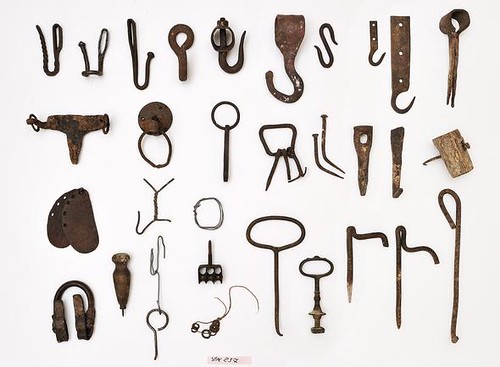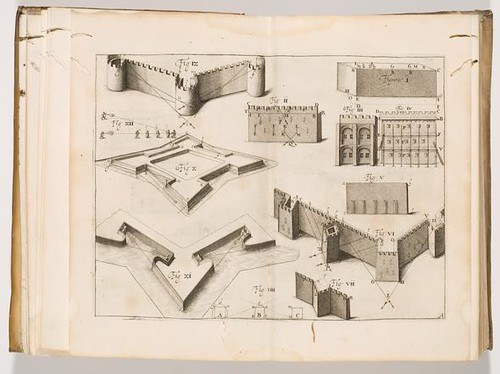Body Radar, Feral Cities, and Cedric Price, Neanderthal
 [Image: Mammoth bone hut; unknown illustrator].
[Image: Mammoth bone hut; unknown illustrator].It's been two weeks now since I arrived in Montreal to begin my summer residency at the Canadian Centre for Architecture, where I am also kicking off the "Bloggers in the Archive" experiment.
It's been fantastic so far, and, in almost every way, is just getting started. After the initial introductory tours and orientations—wandering through "cold vaults" in an obligatory down jacket, looking at children's architectural toys, seeing Gordon Matta-Clark's tax returns, learning about "sulfur bricks" baked in cake trays, flipping through 19th-century photographs of Istanbul's city walls, and, as anyone who follows my Twitter feed might have noticed, going through no less than 17 boxes of archival material from the Underground Space Center Library—I'll now be able to write about the objects, texts, photos, films, and more that I discover (or am shown) here in the voluminous storage rooms of the CCA.
Expect those posts to begin this week and to continue through the end of July.
 [Image: Alessandro Poli, Zeno-research of a self-sufficient culture (1979-80). ©Archivio Alessandro Poli. Photo: Antonio Quattrone. Courtesy of the Canadian Centre for Architecture].
[Image: Alessandro Poli, Zeno-research of a self-sufficient culture (1979-80). ©Archivio Alessandro Poli. Photo: Antonio Quattrone. Courtesy of the Canadian Centre for Architecture].For now, the first five posts that I've written for the CCA are up and ready for reading. You can find any new content that I produce for them in one of two ways: either go to the home page itself and click on the Post-It note at the bottom right, or simply bookmark the tag Geoff@CCA. This is all part of the To CCA, From... series. Unfortunately, there is no way to leave comments on the CCA site, but perhaps use the comment thread here for any reactions, positive or negative, to the posts.
 [Image: Unknown engraver, Series of views showing the development of the modern bastion system from its medieval origins, Matthias Dögen (1647), courtesy of the Canadian Centre for Architecture].
[Image: Unknown engraver, Series of views showing the development of the modern bastion system from its medieval origins, Matthias Dögen (1647), courtesy of the Canadian Centre for Architecture].Over the past week, then, I've looked at urban fortifications and the defensive future of feral cities; through the CCA's extensive periodicals collection, focusing on a brief comment about the relationship between furniture design and weight-lifting equipment; I've taken a behind-the-scenes tour of the CCA's current exhibition Other Space Odysseys, looking specifically at a fictional encounter between an Apollo astronaut and an Italian farmer; I've reviewed the sonic abnormalities of a concert here in Montréal last weekend as part of the MUTEK festival; and, in the most recent post, I've taken a look at the paleolithic history of architecture and the prehistoric design possibilities for an Archigram of mammoth bones.
Actual archival research—live-blogging the archive, so to speak—will begin promptly. Thanks again to the CCA for hosting me!





Comments are moderated.
If it's not spam, it will appear here shortly!
I think this "bloggers in the archives" experiment is very exciting. I has also got me thinking about how we take curated, accessible accounts of things normally inaccessible and bring them further into the public realm. I suggested last week at the new Halifax Library public engagement session that exhibition space in libraries for things like would be exciting. Great work and can't wait to read more posts.
Sorry, but my searching is failing me at getting actual names/links. I think it was you that had a piece on a military operation where the soldiers worked they way through a city by breaking through walls of adjacent buildings, thus never exposing themselves to the outside. I wonder how well a purposefully confusing city would stand up to an assault in which the normal pathways have little value to the invaders.
(Sorry if this double-posts; I hit a snag while submitting.)
http://bldgblog.blogspot.com/2010/01/nakatomi-space.html
Thanks, Kivi.
Thanks, Kivi - you beat me to it!
Really enjoyed the posts on mammoth bone architecture and Mutek. It's interesting, your thoughts on appropriation of military sound for use in a musical/concert context are close in nature to Steve Goodman/Kode9's recent book 'Sonic Warfare', which explores a lot of the same ground. Worth checking out, if you haven't already.
http://sonicwarfare.wordpress.com/
There's some interesting chatter about it in this review/discussion:
http://thequietus.com/articles/03493-hyperdub-2010-a-state-of-the-bass-nation-address
First post, I've recently been introduced to your blog and have been losing afternoons in its archive!
Post a Comment